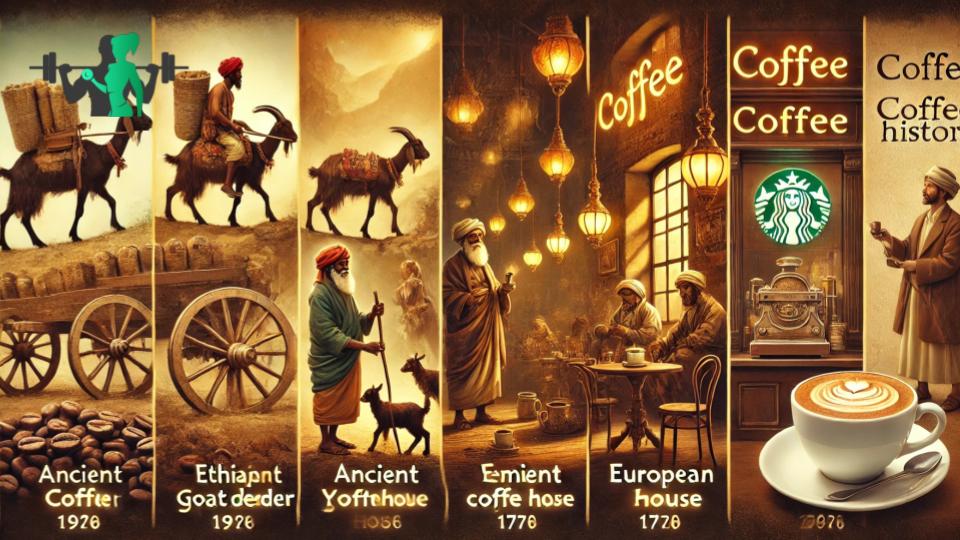Coffee is more than just a drink—it’s a global tradition that has shaped cultures, economies, and societies for centuries. From its mystical discovery in Ethiopia to becoming a worldwide commodity, coffee has an incredible history full of adventure, trade, and transformation.
Let’s explore the fascinating journey of coffee, from its ancient origins to its status as one of the most consumed beverages in the world.
1. The Legend of Coffee: Ethiopia’s Dancing Goats
The story of coffee’s discovery dates back to the 9th century in Ethiopia. According to legend, a goat herder named Kaldi noticed that his goats became unusually energetic after eating red cherries from a particular tree.
What Happened Next?
- Curious, Kaldi tried the cherries himself and felt a sudden surge of energy.
- He took them to a local monastery, where monks used them to create a drink that helped them stay awake during long prayers.
- Word spread, and soon, coffee became known as a mystical, energizing beverage.
Though this is just a legend, Ethiopia is still considered the birthplace of coffee and remains a major coffee producer today.
2. Coffee’s Journey to the Arabian Peninsula
By the 15th century, coffee had made its way to Yemen, where it was cultivated for the first time. The Yemeni city of Mocha became a major center for coffee trade, giving rise to the famous Mocha coffee.
The Role of Coffee in Islamic Culture
- Coffeehouses, known as qahveh khaneh, became popular social hubs in Mecca, Cairo, and Istanbul.
- Coffee was called the “wine of Islam” because it was an acceptable alternative to alcohol.
- Sufi monks used coffee to stay awake during nightly religious rituals.
From Yemen, coffee spread to Persia (Iran), Turkey, and Egypt, where it became an essential part of daily life.
3. Coffee Enters Europe: The Rise of Coffeehouses
By the 16th and 17th centuries, coffee reached Europe through Venetian traders. However, some Europeans were suspicious of this “dark drink” and called it the “bitter invention of Satan.”
How Coffee Won Over Europe
- In 1600, Pope Clement VIII tasted coffee and declared it delicious, helping to remove religious opposition.
- The first coffeehouses appeared in Venice, London, and Paris, becoming intellectual meeting places for artists, philosophers, and politicians.
- By 1700, London alone had over 3,000 coffeehouses, earning the nickname “penny universities” because people could discuss ideas over a cup of coffee for a penny.
Coffee quickly replaced beer and wine as the preferred morning drink, fueling Europe’s Age of Enlightenment.
4. The Coffee Boom in the Americas
As European empires expanded, so did coffee cultivation. Colonial plantations spread coffee to South America, the Caribbean, and Asia.
Key Moments in Coffee’s Expansion
- Brazil (1727): A Portuguese colonist named Francisco de Melo Palheta smuggled coffee seeds into Brazil, starting what would become the largest coffee industry in the world.
- Haiti (18th century): Haiti was once the world’s top coffee exporter, but political instability later impacted production.
- Jamaica (1728): The famous Blue Mountain Coffee was introduced, becoming one of the most sought-after specialty coffees.
By the 19th century, coffee had become a global commodity, fueling economies and international trade.
5. The Birth of Instant Coffee and Modern Coffee Culture
As coffee became more popular, new innovations made it more accessible:
Key Inventions in Coffee History
- 1901: The first instant coffee was invented by Japanese-American chemist Satori Kato.
- 1938: Nescafé was launched by Nestlé, revolutionizing how people drank coffee.
- 1940s–50s: The rise of espresso culture in Italy led to the creation of cappuccinos and lattes.
- 1971: The first Starbucks store opened in Seattle, beginning the era of specialty coffee chains.
Today, coffee is more diverse than ever, with third-wave coffee movements focusing on quality, sustainability, and artisanal brewing methods.
6. Coffee in the 21st Century: A Billion-Dollar Industry
Today, coffee is the second most traded commodity in the world (after oil), with an industry worth over $100 billion.
Global Coffee Trends
- Sustainability: Consumers are demanding more ethically sourced and organic coffee.
- Specialty Coffee: Single-origin and third-wave coffee shops are rising in popularity.
- Cold Brew & Nitro Coffee: New brewing methods are expanding coffee’s possibilities.
- Health & Performance: Coffee is now widely used in fitness and cognitive performance.
From a simple Ethiopian legend to a global obsession, coffee continues to evolve and captivate people worldwide.
Final Thoughts
Coffee has had an incredible journey—from ancient Ethiopian highlands to bustling cafés in every corner of the world. It has fueled revolutions, inspired artists, and connected people across cultures.
Key Takeaways
☕ Coffee originated in Ethiopia and spread through the Arabian Peninsula.
☕ It became a major social and intellectual drink in Europe.
☕ Colonial expansion brought coffee to the Americas, making Brazil the top producer.
☕ The modern coffee industry is now a multi-billion-dollar global phenomenon.
Next time you sip your coffee, remember—you’re drinking a piece of history! ☕🌍
See you.
Read also:

Here we are dedicated to helping you unlock your full potential by focusing on the key pillars of a healthy life: balanced nutrition, restful sleep, mental well-being, and sustainable habits that support long-term health.
